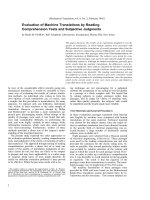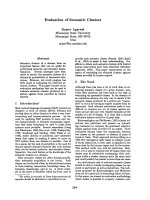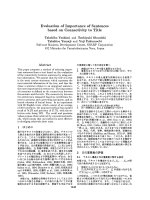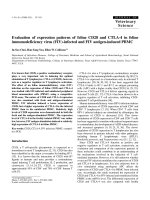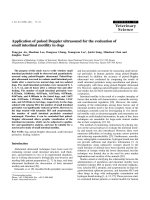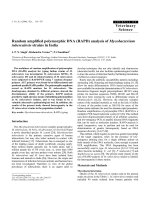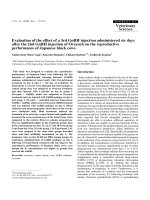Báo cáo khoa học: "Evaluation of adjuvant chemoradiation therapy for ampullary adenocarcinoma: the Johns Hopkins Hospital - Mayo Clinic collaborative study" docx
Bạn đang xem bản rút gọn của tài liệu. Xem và tải ngay bản đầy đủ của tài liệu tại đây (235.38 KB, 31 trang )
This Provisional PDF corresponds to the article as it appeared upon acceptance. Fully formatted
PDF and full text (HTML) versions will be made available soon.
Evaluation of adjuvant chemoradiation therapy for ampullary adenocarcinoma:
the Johns Hopkins Hospital - Mayo Clinic collaborative study
Radiation Oncology 2011, 6:126 doi:10.1186/1748-717X-6-126
Amol K Narang ()
Robert C Miller ()
Charles C Hsu ()
Sumita Bhatia ()
Timothy M Pawlik ()
Dan Laheru ()
Ralph H Hruban ()
Jessica Zhou ()
Jordan M Winter ()
Michael G Haddock ()
John H Donohue ()
Richard D Schulick ()
Christopher L Wolfgang ()
John L Cameron ()
Joseph M Herman ()
ISSN 1748-717X
Article type Research
Submission date 16 June 2011
Acceptance date 28 September 2011
Publication date 28 September 2011
Article URL />This peer-reviewed article was published immediately upon acceptance. It can be downloaded,
printed and distributed freely for any purposes (see copyright notice below).
Articles in Radiation Oncology are listed in PubMed and archived at PubMed Central.
For information about publishing your research in Radiation Oncology or any BioMed Central journal,
go to
Radiation Oncology
© 2011 Narang et al. ; licensee BioMed Central Ltd.
This is an open access article distributed under the terms of the Creative Commons Attribution License ( />which permits unrestricted use, distribution, and reproduction in any medium, provided the original work is properly cited.
/>For information about other BioMed Central publications go to
/>Radiation Oncology
© 2011 Narang et al. ; licensee BioMed Central Ltd.
This is an open access article distributed under the terms of the Creative Commons Attribution License ( />which permits unrestricted use, distribution, and reproduction in any medium, provided the original work is properly cited.
1
Evaluation of adjuvant chemoradiation therapy for ampullary adenocarcinoma: the Johns
Hopkins Hospital - Mayo Clinic collaborative study
Amol K. Narang
1
, Robert C. Miller
2
, Charles C. Hsu
1,3
, Sumita Bhatia
2
, Timothy M. Pawlik
4,5
,
Dan Laheru
5,6
, Ralph H. Hruban
5,7
, Jessica Zhou
1
, Jordan M. Winter
4
, Michael G. Haddock
2
,
John H. Donohue
8
, Richard D. Schulick
4,5
, Christopher L. Wolfgang
4,5
, John L. Cameron
4,5
,
Joseph M. Herman
1,5,*
1
Department of Radiation Oncology, Johns Hopkins University School of Medicine, Baltimore,
MD, USA;
2
Department of Radiation Oncology, The Mayo Clinic, Rochester, MN, USA;
3
Department of Radiation Oncology, University of California, San Francisco, San Francisco, CA,
USA;
4
Department of Surgery, Johns Hopkins University School of Medicine, Baltimore, MD,
USA;
5
The Sol Goldman Pancreatic Research Center, Johns Hopkins University School of
Medicine, Baltimore, MD, USA;
6
Department of Oncology, Johns Hopkins University School of
Medicine, Baltimore, MD, USA;
7
Department of Pathology, Johns Hopkins University School of
Medicine, Baltimore, MD, USA;
8
Department of Surgery, The Mayo Clinic, Rochester, MN,
USA
*Corresponding author
Author email addresses:
AKN:
RCM:
CCH:
SB:
TMP:
DL:
RHH:
JZ:
JMW:
MGH:
JHD:
RDS:
CLW:
2
JLC:
JMH:
Abstract
Background: The role of adjuvant chemoradiation therapy for ampullary carcinoma is unknown.
Previous literature suggests that certain populations with high risk factors for recurrence may
benefit from adjuvant chemoradiation. We combined the experience of two institutions to better
delineate which patients may benefit from adjuvant chemoradiation.
Methods: Patients who underwent curative surgery for ampullary carcinoma at the Johns
Hopkins Hospital (n=290; 1992-2007) and at the Mayo Clinic (n=130; 1977-2005) were
reviewed. Patients with <60 days of follow-up, metastatic disease at surgery, or insufficient
pathologic data were excluded. The final combined study consisted of 186 patients (n=104
Johns Hopkins, n=82 Mayo). Most patients received 5-FU based chemoradiation with conformal
radiation. Cox proportional hazards models were used for survival analysis.
Results: Median overall-survival was 39.9 months with 2- and 5-year survival rates of 62.4%
and 39.1%. On univariate analysis, adverse prognostic factors for overall survival included
T3/T4 stage disease (RR=1.86, p=0.002), node positive status (RR=3.18, p<0.001), and poor
histological grade (RR=1.69, p=0.011). Patients who received adjuvant chemoradiation (n=66)
vs. surgery alone (n=120) showed a higher rate of T3/T4 stage disease (57.6% vs. 30.8%,
P<0.001), lymph node involvement (72.7% vs. 30.0%, P<0.001), and close or positive margins
(4.6% vs. 0.0%, P=0.019). Five year survival rates among node negative and node positive
patients were 58.7% and 18.4% respectively. When compared with surgery alone, use of
adjuvant chemoradiation improved survival among node positive patients (mOS 32.1 vs. 15.7
3
mos, 5yr OS: 27.5% vs. 5.9%; RR=0.47, P=0.004). After adjusting for adverse prognostic factors
on multivariate analysis, patients treated with adjuvant chemoradiation demonstrated a
significant survival benefit (RR=0.40, P<0.001). Disease relapse occurred in 37.1% of all
patients, most commonly metastatic disease in the liver or peritoneum.
Conclusions: Node-positive patients with resected ampullary adenocarcinoma may benefit from
5-FU based adjuvant chemoradiation. Since a significant proportion of patients develop
metastatic disease, there is a need for more effective systemic treatment.
Key Words: ampullary, carcinoma, adjuvant, chemoradiation, resectable
4
Background
Although carcinoma of the ampulla of Vater is a rare malignancy with an overall
incidence of 6 in 1 million, it is the second most common periampullary cancer, comprising 6-
20% of malignancies in this region [1,2,3]. Compared to pancreatic adenocarcinoma, ampullary
cancer is associated with a higher likelihood of resectability and a more favorable prognosis.
Whereas patients with resectable pancreatic adenocarcinoma show a 5-year survival of only
20%, most retrospective reviews of ampullary cancer over the past two decades have reported 5-
year survival between 30-40% [4,5,6,7,8,9,10,11]. The earlier appearance of obstructive
symptoms, more favorable histology, and a decreased inclination for lymphatic or perineural
invasion have all been cited as potential explanations for the better outcomes with ampullary
carcinoma [12].
Pancreaticoduodenectomy (PD) remains the only possible curative treatment for patients
with pancreatic or ampullary cancer, but the role of adjuvant therapy remains controversial. In
the United States, postoperative adjuvant chemoradiation (CRT) has been used for pancreatic
cancer based on evidence suggesting improved survival [4,13,14]. Whether these results can be
extrapolated to resected ampullary carcinoma has been an area of active debate. A 1999
randomized controlled trial by the European Organization for Research and Treatment of Cancer
(EORTC) examined post-operative 5-fluorouracil (5-FU) based CRT in patients with pancreatic
head or other periampullary malignancies. This study demonstrated no survival benefit in
patients with periampullary cancer at 2 or 5 years, but the number of patients with ampullary
carcinoma was small, most of whom had favorable prognostic factors [14]. More recently, a
retrospective review from the MD Anderson Cancer Center showed a borderline significant
5
improvement in survival with CRT in a subset of patients with advanced tumor stage (T3/T4),
while a study from the Mayo Clinic found a survival benefit in patients with pathologic lymph
node involvement [15,16]. A third review from the Johns Hopkins Hospital (JHH) also suggested
a potential survival benefit from CRT in patients with resected ampullary carcinoma who had
lymph node involvement, although this finding was not statistically significant (p=0.092) [17].
While these studies indicate that certain subsets of patients with ampullary carcinoma may
benefit from postoperative CRT, they are limited by the small number of patients analyzed. In
the present study, we combine the experience of two of the aforementioned institutions, namely
the Johns Hopkins Hospital and the Mayo Clinic, to compare surgery followed by modern
conformal 5-FU based adjuvant CRT with surgery alone for patients with resectable carcinoma
of the ampulla of Vater.
Methods
Study design and participants
The study was approved by the institutional review boards of the Mayo Clinic, Rochester,
MN, and the Johns Hopkins Hospital, Baltimore, MD. The study cohort was drawn from all
patients who underwent curative surgery for ampullary carcinoma at the Johns Hopkins Hospital
between 1992 and 2007 (n = 290, prospectively collected) and the Mayo Clinic from 1977 to
2005 (n = 130, retrospectively collected). Cancer of the ampulla of Vater was defined as
adenocarcinoma directly centered on or associated with an in situ carcinoma of the ampulla,
papilla, or both, as evidenced by review of the final pathology report. Patients with cancers
arising from the duodenum, pancreatic head, or common bile duct were not eligible. Patients
who were referred to outside institutions for adjuvant therapy or follow-up care were excluded
6
because information regarding the details of their outcomes or whether they received adjuvant
treatment was unavailable (n=156). Individuals who died within 60 days of surgery (n=6), had
less than 60 days of follow-up (n=6), or had evidence of metastatic disease at surgery (n=11)
were excluded as well. Those missing information on T-stage, tumor size, margin status, node
status, or histologic grade (n=55) were also not analyzed. The final study population contained
186 patients (n=104 JHH, n=82 Mayo).
All patients received preoperative staging by one or more of the following modalities:
abdominal and pelvic-computed tomography (CT), endoscopic retrograde
cholangiopancreatography (ERCP), endoscopic ultrasonography (EUS), and percutaneous
transhepatic cholangiography or percutaneous biliary drainage (PTC/PBD). The majority of
patients (77%) received both CT and ERCP. Laboratory tests included a full blood count, serum
electrolytes, creatinine, urea, liver transaminases, alkaline phosphatase, total bilirubin,
carcinoembryonic antigen (CEA), and carbohydrate antigen 19-9 (CA19-9).
Patient demographic and pathologic data are outlined in Table 1. Of the 186 patients in
the study, 109 (59%) were male. Median age was 68 years (range 29-90 years). Pathologic data
is limited to those variables potentially conferring poor prognosis, including T-stage, tumor size,
lymph node status, histologic grade, and margin status.
Surgery
Patients underwent either a pylorus-preserving or classic pancreaticoduodenectomy (PD).
A pylorus-preserving PD included resection of the head and uncinate process of the pancreas,
distal bile duct, all but the most proximal duodenum, and gallbladder, when present. In a classic
PD, the antrum of the stomach was also resected. At JHH, 82.5% of patients underwent a
7
pylorus-preserving PD, while these data were unavailable for patients treated at the Mayo Clinic.
All pathology specimens were reviewed by either a pathologist at JHH or centrally at the Mayo
Clinic, and patients were restaged according to American Joint Committee on Cancer (AJCC)
guidelines, sixth edition. Pathologic data regarding T stage, tumor size, histologic grade, lymph
node involvement, lymphovascular invasion, perineural invasion, and surgical margins were
recorded. Lymph nodes were considered positive if the resection specimen contained metastatic
carcinoma in any of the lymph nodes, whether they were involved by direct extension or
contiguous with the primary tumor. At the Mayo Clinic, margin status was determined by the
presence of carcinoma at the final pancreatic neck, uncinate process, bile duct, duodenal, or
retroperitoneal soft tissue margin. At JHH, resection margins were considered positive if the
carcinoma was close to (within 1 mm) or present at these margins.
Chemoradiation regimen
Of the 186 patients in this study, 120 (64.5%) received surgery alone, while 66 (35.5%)
were given adjuvant CRT. In patients receiving adjuvant therapy, radiation treatments were
administered with a 3-field coplanar approach (7.6%), 4-field coplanar approach (78.8%), 5-field
non-coplanar approach (3.0%), or intensity modulated radiation therapy (IMRT, 10.6%). A total
of 45 Gy was generally delivered to the ampullary tumor bed (based on preoperative images),
surgical anastomoses (hepatojejunostomy, pancreaticojejunostomy) and adjacent regional lymph
nodes (proximal celiac and superior mesenteric). Additional radiation (5-15 Gy) was
administered to the tumor bed/area of involved margins and anastomoses paying careful attention
to the dose to the small bowel. The median total dose was 50.4 Gy (range 37.8-50.4 Gy).
Radiation was given in consecutive, daily fractions except for 7 patients (10.6%) who underwent
8
a two week planned break in therapy as part of a treatment protocol investigating split-course
chemoradiation. In this protocol, patients received two weeks of 5-fluorouracil based
chemoradiation, a two week treatment break, and two additional weeks of 5-fluorouracil based
chemoradiation, followed by 5-fluorouracil based maintenance chemotherapy. No patient
received neoadjuvant or intraoperative radiation. Concurrent chemotherapy most commonly
consisted of 5-fluorouracil (95.5%), although three patients (4.5%) received gemcitabine.
Maintenance chemotherapy was given to 37.9% of patients in the form of single-agent 5-
fluorouracil (15.2%), single-agent gemcitabine (19.7%), or combination gemcitabine with either
cisplatin/erlotinib (1.5%) or capecitabine (1.5%). All patients who received maintenance
chemotherapy were treated at JHH. Note that patients were not excluded from our analysis based
on the concurrent or maintenance chemotherapeutic agents that were administered given the lack
of clear evidence supporting a specific regimen. None of the patients in this study were treated
with adjuvant chemotherapy alone.
Statistical Analysis
Statistical analysis was performed using STATA, version 9 (Stata, College Station, TX).
Summary statistics for continuous and dichotomous variables are provided. In constructing
dichotomous variables, thresholds were defined in accordance with the literature [15,16,17,18].
The distribution of prognostic variables between treatment groups was compared using Pearson’s
chi-squared test. The primary outcome variable was overall survival (OS), defined as the time
from surgical resection to death. Survival time was censored at date of last follow up if death had
not occurred. Univariate analysis was conducted using the log-rank test to examine risk factors
and associations with mortality. Median OS was estimated within each risk group and by
9
adjuvant treatment. The proportion of individuals surviving up to 2 and 5 years was calculated
using life tables and stratified by treatment group to assess for a significant difference using the
log-rank test. Proportional hazards models were used to examine the association of adjuvant
treatment, baseline patient characteristics, and pathologic data with mortality. To explore the
independent association of adjuvant therapy and OS, multivariate analysis was performed,
adjusting for possible confounders, namely age, sex, institution, tumor stage, tumor size, lymph
node status, and histologic differentiation. Margin status was not included in multivariate
analysis due to a paucity of patients with close or positive margins (n=3). Survival curves were
estimated with Kaplan–Meier techniques.
Results
At the time of analysis, 82 patients (44.1%) were still alive while 104 patients (55.9%)
had died. Progression of disease was the cause of death for 58 patients (55.2%), while the
remaining 46 deaths (44.8%) were from unknown or other causes. Median follow-up time for
surviving patients was 31.7 months (range 2.0 – 160.1 months).
As displayed in Table 1, when compared with patients who were treated with surgery
alone, those patients who received adjuvant CRT were significantly younger (62.0 vs. 68.9, p <
0.001), were more likely from JHH (71.2% vs. 47.5%, p = 0.002), had more advanced T-stage
(T3/T4: 57.6% vs. 30.8%, p = 0.002), and showed more frequent pathologic lymph node
involvement (72.3% vs. 30.0%, p < 0.001). Patients in the CRT group also more frequently had
close or positive surgical margins (4.6% vs. 0.0%, p = 0.019), although only three patients in the
entire sample had close or positive margins, all of whom were given CRT. Histologic grade,
while not significantly different between treatment groups, did show a trend towards poorer
10
differentiation amongst patients given CRT (grade 3: 62.1% vs. 50.0%, p = 0.053). Neither
tumor size nor gender was associated with the type of treatment that the patient received.
Additionally, when patient demographics and tumor characteristics were stratified by institution,
there was no significant difference between the JHH and Mayo cohorts for any of these factors
(results not shown).
Median overall survival (mOS) for all patients was 39.9 months (95% CI: 29.5 – 54.7
months) with a 2-year and 5-year survival of 62.4% and 39.1%, respectively. As displayed in
Table 2, on univariate analysis, lymph node involvement had the strongest association with
decreased overall survival (mOS: 23.0 vs. 79.4 months, RR 2.11 – 4.78, p <0.001). Advanced T-
stage and poor histologic differentiation were also significantly associated with poor prognosis.
Specifically, tumors classified as T3/T4 showed significantly worse overall survival compared
with T1/T2 disease (mOS: 27.0 vs. 55.4 months, RR 1.26 – 2.75, p = 0.002), as did grade 3
histology when compared with grade 1 or 2 disease (mOS: 32.1 vs. 60.0 months, RR 1.13 – 2.53,
p = 0.011). Age, gender, institution, tumor size, and margin status were not predictive of overall
survival. Furthermore, as illustrated in Figure 1, adjuvant treatment with CRT was not
significantly associated with overall survival when compared with surgery alone (median
survival 39.9 vs. 40.1 months, RR 0.64 – 1.43, p = 0.839) using univariate analysis. As shown in
Table 3, when patients were stratified into eight risk groups, and survival by treatment type was
compared within each subgroup, the only patients who showed a significant difference in median
survival between adjuvant CRT and surgery alone were those with pathologic lymph node
involvement (mOS: 32.1 vs. 15.7 months, p = 0.004). In node-positive patients, adjuvant CRT
resulted in a 5-year survival of 27.5%, while surgery alone led to a 5-year rate of only 5.9%.
Figure 2 compares the survival curves by treatment type for node-positive patients. Median
11
survival was also higher in node negative patients receiving adjuvant CRT (mOS: 103.2 vs. 61.6
months), but the difference was not statistically significant (p = 0.122).
As displayed in Table 4, on multivariate analysis, adjuvant CRT was significantly
associated with improved overall survival (RR 0.25 – 0.67, p < 0.001), when adjusted for age,
gender, institution, T-stage, tumor size, node status, and grade. Additionally, lymph node
involvement was the only other variable associated with overall survival on multivariate
analysis, with node positive patients experiencing significantly increased risk of death (RR 2.50
– 7.17, p < 0.001).
Of the 66 patients who underwent adjuvant CRT, 41 (62.1%) experienced some form of
toxicity during therapy. The most common toxicities reported were nausea (25.8%), diarrhea
(16.7%), weight loss (9.1%), fatigue (9.1%), and epigastric pain (7.6%). While side effects
tended to be mild in nature, treatment-related toxicity did lead to an interruption of therapy in 8
patients (12.1%). Grade 3 toxicities were reported in two patients from the Mayo Clinic who
suffered from myelosuppression and sepsis respectively. The grade of toxicity for patients
treated at JHH was unavailable, although no patient from JHH was hospitalized for radiation-
associated toxicity. There were no known treatment related deaths.
Sixty-nine patients (37.1%) experienced a recurrence by the end of follow-up. The most
common pattern of initial recurrence was distant metastasis without local relapse, which was
seen in 49 patients (26.3%). Thirteen patients (7.0%) had both local and metastatic disease at
initial relapse. Only 7 patients (3.8%) presented with local recurrence without evidence of
metastatic spread, of which 6 had not been given adjuvant therapy. The distribution in patterns of
initial recurrence between treatment groups is summarized in Table 5. Overall, the liver was the
most common site of metastasis, with 24.7% of all patients and 36.5% of those patients who died
12
harboring disease in the liver. The peritoneum was the second most common site of metastasis,
present in 5.9% of all patients and 9.5% among those patients who died. Lung metastases were
found in 4.8% of all patients and 6.7% of patients who died, making it the third most common
site of distant spread.
Discussion
This combined series of patients with ampullary carcinoma represents the largest study to
date that demonstrates an overall survival benefit in patients receiving adjuvant chemoradiation
following surgical resection when controlling for adverse prognostic factors. After adjusting for
institution, patient demographics such as age and gender, and disease characteristics such as
tumor stage, tumor size, nodal involvement, and histology, patients treated with adjuvant CRT
experienced enhanced survival (HR= 0.41, 95% CI: 0.25-0.67, p<0.001). This series also
confirms improved outcomes in patients with ampullary carcinoma when compared with
pancreatic cancer, with a median survival of 39.9 months and two and five-year survival rates of
62.4% and 39.1% respectively.
Pancreaticoduodenectomy is the preferred surgical approach for carcinoma of the
ampulla of Vater that is amenable to resection [19]. However, similar to pancreatic cancer, the
role of post-operative adjuvant therapy remains undefined. While prognosis for resectable
ampullary carcinoma is considerably better than for pancreatic cancer, patients with node
positive disease have poor survival and appear to benefit from adjuvant therapy [20,21]. A
number of reports, mostly consisting of single institution series, have established adverse
prognostic factors, including extent of local invasion, status of surgical margins, presence of
nodal metastasis, and histologic grade, all of which predict for overall survival as well as local
13
and distant disease [5-9,22,23,24,25,26,27,28,29]. In these cohorts, nodal involvement has been a
particularly strong predictor of poor outcomes, with 5-year survival rates following PD ranging
from 64-80% in patients with node-negative disease and 17-50% in patients with node-positive
disease. A more recent population-based analysis of roughly 4,000 patients with ampullary
carcinoma was conducted using the National Cancer Institute’s Surveillance, Epidemiology, and
End Results database [30]. Outcomes were slightly worse than the aforementioned series from
specialized cancer centers but were highly dependent on nodal metastasis (5 year survival: 47.6%
vs. 21.0%).
High rates of relapse along with identification of adverse prognostic factors have led to
exploration of adjuvant chemoradiation for “high risk” ampullary carcinoma, although the
literature in this area remains sparse. Willett et al. first reported a trend towards improved local
control with no improvement in overall survival when adjuvant 5-FU based chemoradiation was
given to a small cohort of patients with high risk features, defined as invasion of the pancreas,
nodal metastasis, positive margins, or poor histology [31]. A subsequent review by Mehta et al.
reported a favorable 3-year actuarial survival rate of 44% using adjuvant 5-FU based
chemoradiation in patients with large tumor size, nodal involvement, positive surgical margins,
poor histology, or neurovascular invasion [32]. Similarly, Lee et al. achieved superior disease-
free survival in patients with advanced tumor stage (T3/T4) or positive nodes receiving adjuvant
chemoradiation [33]. On multivariate analysis, adjuvant therapy was also a significantly
favorable factor for the entire cohort (HR: 0.16, p=0.030). However, less than twenty patients
received adjuvant therapy in each of these studies, making it difficult to derive convincing
conclusions.
14
More recently, three retrospective studies from institutions that treat high volumes of
periampullary malignancies reviewed their experience with adjuvant CRT for ampullary
carcinoma. Krishnan et al. examined 96 patients, 54 of whom had received adjuvant CRT
consisting of either preoperative radiation to a median dose of 45 Gy or postoperative radiation
to a median dose of 50.4 Gy, with concurrent 5-FU or capecitabine [15]. Patients with advanced
T-stage (T3/T4) who were treated with CRT showed a borderline significant increase in survival
(mOS: 35.2 vs. 16.5 months, p=0.06). Similarly, a JHH review of 111 patients identified a trend
towards improved survival with adjuvant CRT among those patients with nodal metastasis
(mOS: 30.0 vs. 21.6 months, p=0.092) [17]. Postoperative therapy in this study consisted of a
median radiation dose of 50.4 to the tumor bed and regional nodes with concurrent 5-FU or
capecitabine. Furthermore, a statistically significant difference in survival among patients with
lymph node involvement treated with adjuvant CRT was found in a previous study from the
Mayo Clinic (mOS: 3.4 vs. 1.6 years, p=0.02) [16]. Note, however, that in none of these studies
was adjuvant CRT associated with increased survival on multivariate analysis.
In the present series, adjuvant therapy was not found on univariate analysis to be
associated with increased survival when compared to surgery (mOS: 39.9 vs. 40.1 months, p-
0.839), as summarized in Table 2 and illustrated in Figure 1. This lack of survival benefit is
likely a result of the imbalance in adverse prognostic factors between treatment groups. In this
series, nodal metastasis (p<0.001), advanced T stage (p=0.002), and poorly differentiated
histology (p=0.011) were all significantly associated with decreased survival. While margin
status was not a predictor of survival (p=0.493), margin status is widely considered to be a poor
prognostic factor, and its lack of association with survival in this study may be attributable to the
small number of patients with close or positive margins (n=3). Regardless, the cohort that
15
received CRT had a significantly higher proportion of patients with advanced T-stage (p=0.002),
pathologic lymph node involvement (p<0.001), and positive surgical margins (p=0.019), and a
borderline statistically significant trend towards poorer histologic grade (p=0.053). The fact that
survival was comparable between treatment groups despite these discrepancies suggests the
potential benefit of adjuvant CRT, particularly amongst high risk populations.
Moreover, when baseline demographic and treatment-related characteristics were
adjusted for on multivariate analysis, a significant association between adjuvant therapy and
improved survival appeared. Indeed, this study represents the second reported survival benefit
from adjuvant CRT found on multivariate analysis, albeit with a much larger cohort than was
analyzed in the aforementioned study by Lee et al [33]. Interestingly, when patients were
stratified by baseline demographic and disease-related characteristics, no subgroup showed a
significant survival benefit from adjuvant CRT except for patients with nodal metastasis, who
experienced a large difference in median survival (mOS: 32.1 vs. 17.5 months, p=0.004). As
suggested in multiple previous studies, node-positive patients were found to carry a very poor
prognosis on both univariate analysis (p<0.001) and multivariate analysis (p<0.001), with a
median survival of only 18.4 months. The fact that node-positive patients who were not treated
with adjuvant CRT showed a dismal 5-year survival rate of only 5.9% indicates that this group
may be particularly suited for post-operative therapy. Moreover, while the effect of adjuvant
therapy in node negative patients did not reach statistical significance, the absolute difference in
survival (mOS: 103.2 vs. 61.6 months) is noteworthy and reminiscent of the CONKO-001 trial in
which node negative pancreatic cancer patients experienced superior survival with adjuvant
chemotherapy [34].
16
While good local control was achieved in this study, nearly a third of patients suffered
from distant relapse, and roughly 90% of recurrences were attributable in part to metastatic
disease. Consistent with the literature, the most common sites of metastasis were the liver and
peritoneum. Overall, progression of disease led to more than half of the deaths in the cohort, with
nearly one third of patients who died harboring disease in the liver. The prevalence of metastatic
disease suggests the need for more effective systemic therapy, particularly in high risk patients.
Unfortunately, there is even less information regarding appropriate type and duration of
chemotherapeutic agents when incorporated with radiation for ampullary cancer. Furthermore,
the role of adjuvant chemotherapy alone is an area that has been largely understudied, a remnant
of borrowed U.S. practice patterns supporting adjuvant CRT for resected pancreatic cancer. A
Japanese study of adjuvant mitomycin C and 5-FU for pancreaticobiliary carcinomas found no
overall or disease-free survival benefit in a subset of 24 patients with ampullary carcinoma when
compared to surgery alone [35]. More recent and robust results from the European Study Group
for Pancreatic Cancer (ESPAC) – 3(v2) trial also showed no difference in survival in 304
patients with resected ampullary cancer who were randomized to 5-FU/folinic acid, gemcitabine,
or observation [36]. Combination chemotherapy may provide better results, as a randomized
control trial comparing gemcitabine and cisplatin versus gemcitabine alone in 410 patients with
locally advanced or metastatic biliary or ampullary cancers did show superior survival with the
combination regimen (mOS: 11.7 vs. 8.1 months, p<0.001), although it should be acknowledged
that only 5% of tumors in the study had an ampullary origin [37]. Of note, no study has directly
compared adjuvant chemotherapy alone with adjuvant chemoradiation.
Given the retrospective nature of this study and wide time period over which this study
spanned, our findings are limited by the variability in treatment regimens and the potentially
17
unequal distribution of confounding factors in patient selection between treatment groups.
Certainly, patients in our study were subject to different operative methods, radiation plans, and
chemotherapeutic agents, which we were unable to control for due to incomplete information or
insufficient power. Additionally, this study has shown that patients selected for adjuvant CRT at
the Johns Hopkins Hospital and the Mayo Clinic possessed more adverse prognostic factors than
those treated with surgery alone. While several high risk characteristics were adjusted for in our
analysis, other variables that were not taken into account include performance status and weight
loss, both of which may be correlated with disease outcomes. Since patients who received
adjuvant CRT were significantly younger, it is easy to imagine that healthier patients were more
likely offered adjuvant treatment. The retrospective nature of our study may have also
compromised our ability to accurately capture certain information such as the toxicity data,
which was lower when compared to prior experience [14]. Furthermore, variations in
institutional protocols regarding treatment delivery can be a source of bias in studies analyzing
data from multiple sites, but it should be noted that while the distribution of treatment type did in
fact vary by institution, there was no association between institution and survival on univariate or
multivariate analysis, and institution did not affect outcomes when stratified by treatment type.
Another limitation was the number of patients excluded for either missing data (i.e. stage or
nodal status) or because they were lost to follow-up. It is probable that follow-up was not
consistent among treatment groups, with patients receiving adjuvant therapy likely showing
better follow-up. The number of patients lost to follow along with the number of patients alive at
time of analysis resulted in a low number of documented recurrences. Ideally, we would have
been able to examine the association between adjuvant therapy and patterns of recurrence, but
the low number of recurrences prevented the possibility of meaningful analysis. Nevertheless,
18
this study combines the experience of two high volume institutions to allow for the largest series
to date that has examined the role of adjuvant therapy following surgery for ampullary cancer.
Conclusions
Lymph node involvement, advanced tumor stage, and poor histology are adverse
prognostic factors associated with poor survival in patients with ampullary carcinoma. The
addition of adjuvant chemoradiation likely improves survival in patients with high risk disease,
particularly in those with lymph node involvement. Whether all patients with resectable
ampullary carcinoma should be treated with adjuvant chemoradiation is subject to debate.
Certainly, better systemic therapy is necessary to improve the high rate of distant metastasis
found in this population.
List of abbreviations
PD: pancreaticoduodenectomy; CRT: chemoradiation therapy; EORTC: European Organization
for Research and Treatment of Cancer; 5-FU: 5-fluorouracil; JHH: Johns Hopkins Hospital; CT:
computed tomography; ERCP: endoscopic retrograde cholangiopancreatography; EUS:
endoscopic ultrasonography; PTC: percutaneous transhepatic cholangiography; PBD:
percutaneous biliary drainage; CEA: carcinoembryonic antigen; CA19-9: carbohydrate antigen
19-9; AJCC: American Joint Committee on Cancer; IMRT: intensity modulated radiation
therapy;
19
Competing interests
The authors declare that they have no competing interests.
Authors’ contributions
AKN participated in the analysis and interpretation of data and drafting of the manuscript. RCM
contributed to study design and provided critical revisions. CCH was involved in study design,
acquisition and analysis of data, and critical review of the manuscript. SB helped with
acquisition and analysis of data and critical review of the manuscript. TMP contributed to
interpretation of data and provided critical revisions. DL was involved with interpretation of data
and critical review of the manuscript. RHH provided analysis and interpretation of data and
critical revisions. JZ contributed to acquisition and analysis of data and critical review of the
manuscript. JMW was involved in analysis and interpretation of data and critical review of the
manuscript. MGH helped with study design and interpretation of data and provided critical
revisions. JHD participated in interpretation of data and critical review of the manuscript. RDS
provided interpretation of data and critical revisions. CLW contributed to study design,
interpretation of data, and critical review of the manuscript. JLC participated in study design,
interpretation of data, and critical revisions. JMH contributed to study conception and design,
interpretation of data, and drafting of the manuscript. All authors have read and approved the
final manuscript.
Acknowledgements
This work was in part supported by the Claudio X Gonzalez Family Foundation.
20
References
1
Yeo CJ, Cameron JL, Sohn TA, Lillemoe KD, Pitt HA, Talamini MA, Hruban RH, Ord SE, Sauter PK, Coleman J,
Zahurak ML, Grochow LB, Abrams RA: Six hundred fifty consecutive pancreaticoduodenectomies in the 1990s.
Pathology, complication and outcomes. Ann Surg 1997, 226:248–260.
2
Bouvet M, Gamagami RA, Gilpin EA, Romeo O, Sasson A, Easter DW, Moossa AR: Factors influencing
survival after resection for periampullary neoplasms. Am J Surg 2000, 180:13–17.
3
Stephens J, Kuhn J, O'Brien J, Preskitt J, Derrick H, Fisher T, Fuller R, Lieberman Z: Surgical morbidity,
mortality, and long term survival in patients with pancreatic cancer following pancreaticoduodenectomy. Am
J Surg 1997, 174:600–604.
4
Kalser MH, Ellenberg SS: Pancreatic cancer: adjuvant combined radiation and chemotherapy following
curative resection. Arch Surg 1985, 120:899–903.
5
Matory YL, Gaynor J, Brennan M: Carcinoma of the ampulla of Vator. Surg Gynecol Obstet 1993, 177:366–
370.
6
Monson JR, Donohue JH, McEntee GP, McIlrath DC, van Heerden JA, Shorter RG, Nagorney DM, Ilstrup DM:
Radical resection for carcinoma of the ampulla of Vater. Arch Surg 1991, 126:353–357.
7
Talamini MA, Moesinger RC, Pitt HA, Sohn TA, Hruban RH, Lillemoe KD, Yeo CJ, Cameron JL:
Adenocarcinoma of the ampulla of Vater: a 28-year experience. Ann Surg 1997, 225:590–600.
8
De Castro SM, Kuhlmann KF, van Heek NT, Busch OR, Offerhaus GJ, van Gulik TM, Obertop H, Gouma DJ:
Recurrent disease after microscopically radical (R0) resection of periampullary adenocarcinoma in patients
without adjuvant therapy. J Gastrointest Surg 2004, 8:775–784.
9
Howe JR, Klimstra DS, Moccia RD, Conlon KC, Brennan MF: Factors predictive of survival in ampullary
carcinoma. Ann Surg 1998, 228:87–94.
10
Brown KM, Tompkins AJ, Yong S, et al. Pancreaticoduodenectomy is curative in the majority of patients with
node negative ampullary cancer. Arch Surg 2005;140:529–533.
11
El-Ghazzawy AG, Wade TP, Virgo KS, Johnson FE: Recent experience with the cancer of the ampulla of
Vater in a national hospital group. Am Surg 1995, 61:607–611.
21
12
Klempnauer J, Ridder GJ, Pichlmayr R: Prognostic factors after resection of ampullary carcinoma:
Multivariate survival analysis in comparison with ductal cancer of the pancreatic head. Br J Surg 1995,
82:1686–1691.
13
Gastrointestinal Tumor Study Group: Further evidence of effective adjuvant combined radiation and
chemotherapy following curative resection of pancreatic cancer. Cancer 1987, 59:2006–2010.
14
Klinkenbijl JH, Jeekel J, Sahmoud T, van Pel R, Couvreur ML, Veenhof CH, Arnaud JP, Gonzalez DG, de Wit
LT, Hennipman A, Wils J: Adjuvant radiotherapy and 5- Fluorouracil after curative resection of cancer of the
pancreas and periampullary region. Phase III trial of the EORTC Gastrointestinal Tract Cancer Cooperative
Group. Ann Surg 1999, 230:776–784.
15
Krishnan S, Rana V, Evans DB, Varadhachary G, Das P, Bhatia S, Delclos ME, Janjan NA, Wolff RA, Crane CH,
Pisters PW: Role of adjuvant chemoradiation therapy in adenocarcinomas of the ampulla of vater. Int J Radiat
Oncol Biol Phys 2008, 70:735–743.
16
Bhatia S, Miller RC, Haddock MG, Donohue JH, Krishnan S: Adjuvant therapy for ampullary carcinomas:
the Mayo Clinic experience. Int J Radiat Oncol Biol Phys 2006, 66:514–519.
17
Zhou J, Hsu CC, Winter JM, Pawlik TM, Laheru D, Hughes MA, Donehower R, Wolfgang C, Akbar U, Schulick
R, Cameron J, Herman JM. Adjuvant chemoradiation versus surgery alone for adenocarcinoma of the ampulla
of Vater. Radiotherapy and Oncology 2009, 92:244-248.
18
Horowitz DP, Hsu CC, Wang J, Makary MA, Winter JM, Robinson R, Schulick RD, Cameron JL, Pawlik TM,
Herman JM: Adjuvant chemoradiation therapy after pancreaticoduodenectomy in elderly patients with
adenocarcinoma. Int J Radiat Oncol Biol Phys, in press.
19
Winter JM, Cameron JL, Olino K, Herman JM, de Jong MC, Hruban RH, Wolfgang CL, Eckhauser F, Edil BH,
Choti MA, Schulick RD, Pawlik TM: Clinicopathologic analysis for ampullary neoplasms in 450 patients:
implications for surgical strategy and long-term prognosis. J Gastrointest Surg 2010, 14:379-387.
20
Kopelson G: Curative surgery for adenocarcinoma of the pancreas/ampulla of Vater: the role of adjuvant
pre or postoperative radiation therapy. Int J Radiat Oncol Biol Phys 1983, 9:911–915.
21
Kopelson G, Galdabini J, Warshaw AL, Gunderson LL: Patterns of failure after curative surgery for extra-
hepatic biliary tract carcinoma: Implications for adjuvant therapy. Int J Radiat Oncol Biol Phys 1981, 7:413–
417.
22
22
Allema JH, Reinders ME, van Gulik TM, van Leeuwen DJ, Verbeek PC, de Wit LT, Gouma DJ: Results of
pancreaticoduodenectomy for ampullary carcinoma and analysis of prognostic factors for survival. Surgery
1995, 117:247-253.
23
Neoptolemos JP, Talbot IC, Shaw DC: Long-term survival after resection of ampullary carcinoma is
associated independently with tumor grade and a new staging classification that assesses local invasiveness.
Cancer 1988, 61:1403-1407.
24
Beger HG, Treitschke F, Gansauge F, Harada N, Hiki N, Mattfeldt T: Tumor of the ampulla of Vater:
experience with local or radical resection in 171 consecutively treated patients. Arch Surg 1999, 134:526-532.
25
Yeo CJ, Sohn TA, Cameron JL, Hruban RH, Lillemoe KD, Pitt HA: Periampullary adenocarcinoma: analysis
of 5-year survivors. Ann Surg 1998, 227:821-831.
26
Duffy JP, Hines OJ, Liu JH, Ko CY, Cortina G, Isacoff WH, Nguyen H, Leonardi M, Tompkins RK, Reber HA:
Improved survival for adenocarcinoma of the ampulla of Vater: fifty-five consecutive resections. Arch Surg
2003, 138:941-948.
27
Hsu HP, Yang TM, Hsieh YH: Predictors for patterns of failure after pancreaticoduodenectomy in
ampullary cancer. Ann Surg Oncol 2007, 14:50-60.
28
Delcore R Jr, Connor CS, Thomas JH, Friesen SR, Hermreck AS: Significance of tumor spread in
adenocarcinoma of the ampulla of Vater. Am J Surg 1989, 158:593-596.
29
Shutze WP, Sack J, Aldrete JS: Long-term follow-up of 24 patients undergoing radical resection for
ampullary carcinoma, 1953 to 1988. Cancer 1990, 66:1717-1720.
30
O'Connell JB, Maggard MA, Manunga J Jr, Tomlinson JS, Reber HA, Ko CY, Hines OJ: Survival after
resection of ampullary carcinoma: a national population-based study. Ann Surg Onc 2008, 15:1820-1827.
31
Willett CG, Warshaw AL, Convery K, Compton CC: Patterns of failure after pancreaticoduodenectomy for
ampullary carcinoma. Surg Gynecol Obstet 1993, 176:33–38.
32
Mehta VK, Fisher GA, Ford JM, Poen JC, Vierra MA, Oberhelman HA, Bastidas AJ: Adjuvant
chemoradiotherapy for ‘‘unfavorable’’ carcinoma of the ampulla of Vater: Preliminary report. Arch Surg
2001, 136:65–69.
23
33
Lee JH, Whittington R, Williams NN, Berry MF, Vaughn DJ, Haller DG, Rosato EF: Outcome of
pancreaticoduodenectomy and impact of adjuvant therapy for ampullary carcinomas. Int J Radiat Oncol Biol
Phys 2000, 47:945–953.
34
Oettle H, Post S, Neuhaus P, Gellert K, Langrehr J, Ridwelski K, Schramm H, Fahlke J, Zuelke C, Burkart C,
Gutberlet K, Kettner E, Schmalenberg H, Weigang-Koehler K, Bechstein WO, Niedergethmann M, Schmidt-Wolf I,
Roll L, Doerken B, Riess H. Adjuvant chemotherapy with gemcitabine vs observation in patients undergoing
curative-intent resection of pancreatic cancer. JAMA. 2007, 297:267–277.
35
Takada T, Amano H, Yasuda H, Nimura Y, Matsushiro T, Kato H, Nagakawa T, Nakayama T: Is postoperative
adjuvant chemotherapy useful for gallbladder carcinoma? A phase III multicenter prospective randomized
controlled trial in patients with resected pancreaticobiliary carcinoma. Cancer 2002, 95:1685-1695.
36
Neoptolemos JP, Moore MJ, Cox TF, Valle JW, Palmer DH, Mcdonald A, Carter R, Tebbutt NC, Dervenis C,
Smith D, Glimelius B, Coxon FY, Lacaine F, Middleton MR, Ghaneh P, Bassi C, Halloran C, Olah A, Rawcliffe
CL, Büchler MW: Ampullary cancer ESPAC-3 (v2) trial: A multicenter, international, open-label, randomized
controlled phase III trial of adjuvant chemotherapy versus observation in patients with adenocarcinoma of
the ampulla of vater [abstract]. J Clin Oncol 2011, 29:abstr LBA4006.
37
Valle J, Wasan H, Palmer DH, Cunningham D, Anthoney A, Maraveyas A, Madhusudan S, Iveson T, Hughes S,
Pereira SP, Roughton M, Bridgewater J: Cisplatin plus gemcitabine versus gemcitabine for biliary tract cancer.
N Engl J Med 2010, 14:1273-1281.
